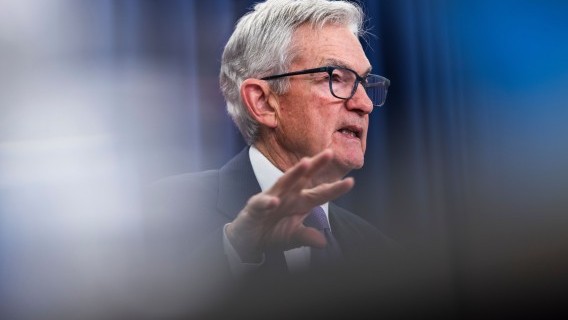Resume af teksten:
I går varslede Feds konference, ledet af Jerome Powell, forskellige interne synspunkter vedrørende fremtidig pengepolitik, hvilket medførte en 10 basispunkt omvurdering af rentenedsættelsescyklussen og styrkede dollaren. Lavrentevalutaer som yen og schweizerfranc er mest sårbare over for denne styrkelse, mens råvare-relaterede valutaer ser en opblødning i US-Kina-forholdet positivt. Powell sagde, at en December-rentenedsættelse ikke er givet, og forventningerne til en 25bp nedsættelse faldt fra 100% til 70%. Stærkere dollar presser EUR/USD forholdet, og Europa håber på positiv 3. kvartals BNP-data. I Storbritannien påvirkes pundet af Bank of Englands fremtidige renteplaner, hvor en mere lempelig tilgang er prissat ind. Central- og Østeuropa ser divergens i BNP-data, mens stærkere USD-satser kan påvirke valutakryds.
Fra ING:
News from Powell’s press conference that the Fed has strongly differing views about the future path for policy has prompted a 10bp re-assessment of the Fed easing cycle and provided support for the dollar. Most vulnerable to firmer USD rates are the low-yielding yen and Swiss franc, whereas commodity-backed FX is welcoming a thaw in US-China relations

Last night’s FOMC press conference saw Chair Jerome Powell emphasising that a December rate cut was not a “foregone conclusion”
![]()
USD: Fed discord makes the dollar a tougher sell
The dollar is broadly, albeit modestly, stronger after last night’s FOMC statement and press conference . The statement was largely as expected, but the press conference turned into a kind of ‘rate protest’ from the Federal Reserve. Here, Fed Chair Jerome Powell seemed to be working off a new script and emphasising that a December rate cut was not a “foregone conclusion”. That saw pricing of a 25bp December rate cut drop to 70% from around 100% prior. The Fed would now argue that a 70% probability is still too high. Learning that the policy rate was not on a glide path to the 3.00/3.25% area saw investors pay up the short-end of the US rate curve and take about 10bp out of the expected easing cycle. A bearish flattening of the curve was most felt against the low-yielding currencies of the Swiss franc and the yen, while commodity FX was a little more insulated on the back of improving trade relations between the US and China. The one-year delay in Chinese export controls on rare earths seems a big win for global supply chains.
Interestingly, US equities have stayed relatively well bid, suggesting that the AI corporate earnings story, rather than Fed easing, is the main driver of this year’s narrow but impressive gains in the S&P 500. Overnight, Meta, Alphabet and MSFT produced a mixed set of results – although top-line revenue did seem to deliver.
Going back to the Fed, it does seem a December rate cut is in the balance now. The central bank sounds more relaxed on inflation, but equally, the jobless claims data from the state level is telling the Fed that the employment situation is not deteriorating any further. And with consumption and business investment performing well, it now seems that there’s a healthy internal debate on whether the neutral policy rate is closer to 4.00% than 3.00%. Powell characterised this as strongly differing views over the future path of the policy rate.
Last night’s Fed communication makes it harder to sell the dollar now. We will really need to see some soft US jobs data to firm up views of another 75bp of easing from the central bank into next summer. Otherwise, 25bp could easily be priced out of that cycle.
Beyond the weekly jobless claims data today, the ongoing shutdown means the US data calendar is quiet. Expect the dollar to remain bid, especially versus the yen, where the Bank of Japan seems in no hurry to tighten policy – seemingly needing more data on wage negotiations and food inflation before hiking again. 155 is the risk here. DXY looks as though it could hang around in the top half of the 98-100 trading range for a while.
Chris Turner
![]()
EUR: Focus on 3Q GDP releases
It could have been worse for EUR/USD. Consensus and ING’s view for a rally in EUR/USD towards 1.20 into year-end largely depends on a dovish Fed. It is not as though we are particularly bullish on the euro. Last night’s Fed meeting therefore makes that 1.20 year-end call a little harder to achieve. That said, EUR/USD found some support below 1.1600 overnight, which suggests investors are much better balanced in terms of dollar positioning than they were back in April – something Francesco Pesole has been discussing this week .
Where does EUR/USD go from here? Today, we’ll see third-quarter GDP data from the eurozone. Remember that survey data has been encouraging, but the hard data has so far been poor this summer. Welcome news has already been seen this morning with French third-quarter GDP coming in at 0.5% quarter-on-quarter versus 0.2% as expected. But unless we get a big upside surprise to eurozone GDP – expected at 0.1% QoQ – it is hard to see EUR/USD getting much of a lift.
We also have the small matter of today’s European Central Bank meeting. However, we doubt President Christine Lagarde will feel the need to rock the boat of market pricing, which very marginally favours another cut sometime over the next nine months.
1.1640/50 looks to be the top of the short-term range, and EUR/USD looks more vulnerable to 1.1550 now, given last night’s communication from the Fed. Downside risks could also emerge from any flash October CPI releases from Germany, Spain and Belgium today.
Chris Turner
![]()
GBP: Don’t chase the sterling sell-off
We had quite a few questions from journalists yesterday about the sterling sell-off and the fact that Gilt yields were falling. That did not seem to fit with a ‘Sell UK’ theme ahead of the November budget. We see the sterling move much more from the Bank of England perspective. Here, investors expect UK Chancellor Rachel Reeves to hold the line on her fiscal rules and perhaps deliver greater fiscal tightening in a move to rebuild budget headroom. This means that the BoE will have to take the strain by lowering interest rates earlier. We have seen a decent move in GBP swap rates this month as investors reprice the BoE terminal rate down to 3.25% next summer.
However, that repricing of the BoE cycle might have come far enough for the time being – meaning that it is a little dangerous to chase sterling through big support in GBP/USD at 1.3140/50 or above the 0.8850/70 area in EUR/GBP. A BoE that retains some of its hawkish rhetoric could actually see sterling reverse some of its losses at next week’s MPC meeting.
Chris Turner
![]()
CEE: GDP numbers to prove more divergence across the region
Yesterday’s Fed ended the risk-on mood for CEE currencies, and the drop in EUR/USD suggests some losses for the region in EUR-crosses today as well. On the other hand, the jump in USD rates will push the CEE rates market up, which could somewhat mitigate the impact of a stronger US dollar. As we discussed yesterday, long positioning leaves the Hungarian forint and, to some extent, the Polish zloty open to the global story more than usual, and it is in this order that today we see sensitivity to the sell-off following yesterday’s Fed meeting. Still, we should also see a continuation of the trade story from US President Donald Trump’s visit to Asia, which could see the return of a more positive mood to the market.
At the same time, Hungary and the Czech Republic will publish flash GDP figures for the third quarter this morning. In the Czech Republic, we see some upside compared to the market consensus, while in Hungary, we see some downside. More attention should be paid to the numbers in Hungary, where the room for undershooting expectations is more significant, and at the same time, this has already somehow been communicated by the Minister for National Economy, Marton Nagy. In an interview, he mentioned numbers around 0.5% year-on-year (0.6% ING estimate), while the market expects 1.0% YoY. This should add to the negative sentiment coming from the global story, and EUR/HUF could head higher towards the 390 level in our opinion.
On the other hand, the Czech GDP number could only support the currency and divert some global pressure. At the same time, the Czech National Bank blackout period starts today, and we should see at least one interview from the bank board. EUR/CZK should not move too far from 24.350.
Chris Turner
Hurtige nyheder er stadig i beta-fasen, og fejl kan derfor forekomme.


